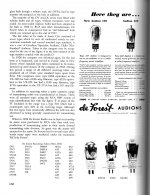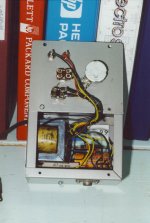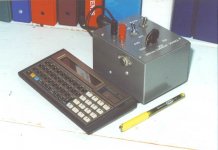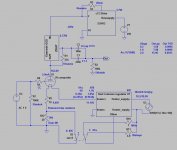Nice picture - I have finished my 01a preamp week ago, but my tubes are not so bright - light is barely visible.
Does it have to do something with manufacturer of tubes or their state? I use Cunningham globe 301a.
I am pretty sure that I have biased them well - 0,03 volts drop on 10R resistor. Filaments are 3.4 volts exactly when measured with multi meter.
By the way, it sounds is very nice. 🙂
Does it have to do something with manufacturer of tubes or their state? I use Cunningham globe 301a.
I am pretty sure that I have biased them well - 0,03 volts drop on 10R resistor. Filaments are 3.4 volts exactly when measured with multi meter.
By the way, it sounds is very nice. 🙂
Hi Ludwig. You can DC couple with stacked supplies and an input transformer to couple the preamp. That is what I did years ago with the 814 SE Amp. I used a 46 driver with filament bias (crazy waste of power) as I always loved its sound. The input transformer was 1:8. You need a low impedance source to drive it. for a preamp you can get a nice 1:1 input transformer. However, there is no free lunch. You will end up with the complexity of 3 stacked power supplies. Believe me, I've been there and done that. It sounded great but not sure I'd go again with such a monster big amp.
I think is preferably having 2 stages if you can, rather than 3.
Still am unclear as to what you're after.
Thanks
Ale
I think is preferably having 2 stages if you can, rather than 3.
Still am unclear as to what you're after.
Thanks
Ale
but my tubes are not so bright - light is barely visible.
Filaments are 3.4 volts exactly when measured with multi meter.
That is the answer.
01a requiring 5V/0.25A as filament.
I think that in Ale's preamp that is on picture above they are slightly starved - 3,4V 0.2A, so there should not be difference with mine.
Otherwise you are absolutely right - they will be more bright at 5V 0,25A.
Otherwise you are absolutely right - they will be more bright at 5V 0,25A.
I have several TT filament old tubes (01/201, 10, 801, 841 etc.).
80-90 years old tubes filament -hot- resistance rarely remains as accurate as the time of manufacture.
The difference -due to the wear- can be significant.
TT filament is thinning every time you turn on or off, so resistance continuously growing.
80-90 years old tubes filament -hot- resistance rarely remains as accurate as the time of manufacture.
The difference -due to the wear- can be significant.
TT filament is thinning every time you turn on or off, so resistance continuously growing.
TT filament is thinning every time you turn on or off, so resistance continuously growing.
Is it better to leave it on continuously, then? My system is on pretty much 24/7.
Hi,
How is solved the problem of the volume pot in such HIGH END tube preamp ?
Shunt pot design as here https://www.audialonline.com/topics/cermet-potentiometers/ ?
Muse "digital" volume chip (without embeded oap) ?
Does this great design solves the problem of the sound of the cables (output/inputt modulation cables towards the source and amp) ?
Sorry, from a newbie with tubes !
How is solved the problem of the volume pot in such HIGH END tube preamp ?
Shunt pot design as here https://www.audialonline.com/topics/cermet-potentiometers/ ?
Muse "digital" volume chip (without embeded oap) ?
Does this great design solves the problem of the sound of the cables (output/inputt modulation cables towards the source and amp) ?
Sorry, from a newbie with tubes !
I think that in Ale's preamp that is on picture above they are slightly starved - 3,4V 0.2A, so there should not be difference with mine.
Otherwise you are absolutely right - they will be more bright at 5V 0,25A.
It's current starvation, so voltage across the filament will vary depending on the valve filament resistance. You should measure current, not voltage across the filament
I have several TT filament old tubes (01/201, 10, 801, 841 etc.).
80-90 years old tubes filament -hot- resistance rarely remains as accurate as the time of manufacture.
The difference -due to the wear- can be significant.
TT filament is thinning every time you turn on or off, so resistance continuously growing.
I haven't noticed any degradation so far with the 01a. Starvation with non-TT filaments (e.g. 4P1L) isn't a problem. In fact, some of the microphonic noise is reduced significantly after 300 hours of play.
Here's an interesting note from Steve Bench (you have probably seen it before) who also suggest the same.
DHT with starved filaments.
Miller-Larson effect
Some discussion about Miller-Larson effect, which shortens the life of thoriated tungsten filaments.
Thoriated Tungsten Filament power cycling
BTW:
If you starving the filament, and decreasing the TT filament temperature from 2150K to 1900-2050K, the tube's life expectancy increasing to ten to hundred times.
Some discussion about Miller-Larson effect, which shortens the life of thoriated tungsten filaments.
Thoriated Tungsten Filament power cycling
BTW:
If you starving the filament, and decreasing the TT filament temperature from 2150K to 1900-2050K, the tube's life expectancy increasing to ten to hundred times.
Hi Bela
I was aware of the Miller-Larson effect, however with DC regulation and the slow turn-on of the CCS-based circuit of Rod's regulator, I'd expect this to be minimised.
I wasn't aware of the increase of life expectancy when operating it at that level. Good to know now 🙂
I was aware of the Miller-Larson effect, however with DC regulation and the slow turn-on of the CCS-based circuit of Rod's regulator, I'd expect this to be minimised.
I wasn't aware of the increase of life expectancy when operating it at that level. Good to know now 🙂
Hi Ludwig. You can DC couple with stacked supplies and an input transformer to couple the preamp. That is what I did years ago with the 814 SE Amp. I used a 46 driver with filament bias (crazy waste of power) as I always loved its sound. The input transformer was 1:8. You need a low impedance source to drive it. for a preamp you can get a nice 1:1 input transformer. However, there is no free lunch. You will end up with the complexity of 3 stacked power supplies. Believe me, I've been there and done that. It sounded great but not sure I'd go again with such a monster big amp.
I think is preferably having 2 stages if you can, rather than 3.
Still am unclear as to what you're after.
Thanks
Ale
----------------------------------------------------------------
Dc Coupling is 🙂no problem if we include a -ve supply along with the +ve on a common rail. Easy to do from the same HT transformer with a CT on the secondary. While in a research capacity I built many PS that did just that. With toobz. That wuz in the late 50s & early 60s.
I think is preferably having 2 stages if you can, rather than 3.
Still am unclear as to what you're after.
Thanks
Ale
----------------------------------------------------------------
Dc Coupling is 🙂no problem if we include a -ve supply along with the +ve on a common rail. Easy to do from the same HT transformer with a CT on the secondary. While in a research capacity I built many PS that did just that. With toobz. That wuz in the late 50s & early 60s.
🙂I get the sense that some here are measuring their 01A heater resistance with ordinary VTVMs or VOMs. Whether digital or not, different makes of meters will give different answers. We don't know what current is applied during the measurement.
To get an accurate answer a constant current power supply is useful. Some example measurement results are attached. I don't have any 01A's in my stash, altho they were quite common when I started out. In 1969 I built a very useful CC Supply, still in use today.
For those who already know all this, no need to go further. Not required reading, there is no test at the end.
Cheers to all, John L Stewart
In case you wonder, I've built something like 50 amplifiers. But those were never my day job!!
To get an accurate answer a constant current power supply is useful. Some example measurement results are attached. I don't have any 01A's in my stash, altho they were quite common when I started out. In 1969 I built a very useful CC Supply, still in use today.
For those who already know all this, no need to go further. Not required reading, there is no test at the end.
Cheers to all, John L Stewart
In case you wonder, I've built something like 50 amplifiers. But those were never my day job!!
Attachments
It's current starvation, so voltage across the filament will vary depending on the valve filament resistance. You should measure current, not voltage across the filament
Ok, that is clear. But you can measure current inline with circuit or voltage across resistor to calculate current.
How do you do it? Measure voltage across filament resistor and set it to 4V on Rod' regulator? 4V/20R=0,2A. I will try it that way back home and check voltage drop across filaments. Might be reason of dim filaments.
If it's too cumbersome to place an ammeter in series then you have to measure first the resistance of the filament bias resistor. Then you can calculate target V=203mA*R that you should read with your voltmeter across the filament bias resistor. With the filament starvation you should expect a dimmer emission though.
Hm, all this is dragging me kicking and screaming towards making an 01A pre. Now my type 26 is pretty much settled, I will need to know if it's PSU can be easily modified to run a 01A chassis. And of course find at least couple of 01As!
BTW I have incorporated a connection in my 26 so I can plug in an ammeter to adjust the filament bias; no room for permanent meters on the top plate, sadly
BTW I have incorporated a connection in my 26 so I can plug in an ammeter to adjust the filament bias; no room for permanent meters on the top plate, sadly
MY #26 HT in the separate PSU chassis is this, which I would need to use, with mods -
I would expect to make another chassis for the 01A, with another set of Coleman regs, the gyrators (instead of the LL2745s) another pair of chokes and caps, sockets, pot, etc, to replace all of this -

Is this sensible?
An externally hosted image should be here but it was not working when we last tested it.
I would expect to make another chassis for the 01A, with another set of Coleman regs, the gyrators (instead of the LL2745s) another pair of chokes and caps, sockets, pot, etc, to replace all of this -

Is this sensible?
- Home
- Amplifiers
- Tubes / Valves
- 01A question



